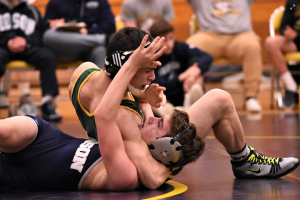Wrestling is a popular combat sport and martial art that involves intense grappling techniques. With origins dating back to ancient history, wrestling has evolved into a global sport practiced from youth levels through high school, college, and professional leagues. As a result, wrestling for kids has become a common introduction to competitive grappling
In its modern form, wrestling takes place on wrestling mats with competitors wearing headgear, singlets, and special shoes. Matches consist of rounds where opponents use takedowns, pins, escapes, and submissions like arm bars to defeat their adversary. Points are awarded for actions like takedowns and near falls. Ultimately the wrestler who scores the most points or secures a pin or submission is declared the winner.
Wrestling teaches core skills like leverage, explosive power, and cardiovascular conditioning. The intense one-on-one competition builds mental fortitude and discipline in kids. As such, youth wrestling programs continue growing in popularity for introducing children to grappling martial arts in a structured environment.
Table of Contents
Toggle
Table of Contents
Toggle![]()
Key Styles of Wrestling for Kids
Several styles of wrestling are practiced in youth and school programs, each with its unique techniques and strategies.
Freestyle Wrestling
- Originated in Europe but is now popular worldwide
- Focuses on explosive takedowns and fast-paced aggression
- Allows for a wide variety of holds and pins both above and below the waist
- Excellent foundation in takedown skills and conditioning
Greco-Roman Wrestling
- Developed in ancient Greece and emphasizes upper body strength
- Restricts holds below the waist and use of the legs in takedowns
- Favor throws, lifts, and drags for takedowns rather than leg attacks
- Builds tremendous core and upper body power
Folkstyle Wrestling
- The most common style practiced in American middle schools, high schools, and colleges
- Emphasizes control and strategy over explosive power
- Rewards wrestlers who can dominate positions and wear down opponents
- Longer match times test mental toughness and endurance
![]()
5 Benefits of Wrestling for Kids

Wrestling provides a variety of benefits for children’s physical and mental development. Here are some of the most important benefits of wrestling for kids:
-
Wrestling builds powerful athleticism in kids:
The constant drilling and sparring develop coordination, agility, endurance, and explosiveness. Core and functional strength is built through full-body wrestling movements. Cardiovascular fitness is enhanced through the fast-paced, high-intensity training. Gross motor skills like balance, positioning, and body control are honed through live grappling. Overall, wrestling transforms kids into elite athletic machines ready for any physical challenge or sport.
-
Wrestling instills iron-willed self-discipline:
To succeed in wrestling requires a diligent commitment to rigorous daily training. A strong work ethic must be forged as kids are pushed to their limits mentally and physically. Wrestling teaches kids to manage emotions, delay gratification and, persist through adversity. Goal-setting and personal responsibility are integral as young wrestlers take ownership of their development. Wrestling forges a lifelong sense of self-discipline.
-
Wrestling dramatically boosts confidence:
As skills improve, kids gain a sense of achievement and belief in themselves. Wrestling allows youth to test their capacities against intense challenges. Through this process of confronting fears and sticking through difficulties, unshakeable confidence is built. Kids gain a supportive community of teammates but also learn to take risks and bet on themselves. Wrestling mat experience breeds confidence that transfers far beyond sports.
-
Wrestling develops a strong yet healthy competitive spirit:
Kids feel the drive to work hard, improve and win. But they also learn to succeed with humility and lose with grace. Respect and sportsmanship toward opponents are integral. Wrestling channels competitiveness into a positive force rather than a destructive one. Kids learn to pursue excellence, not glory.
-
Wrestling teaches invaluable self-defense skills:
The constant live grappling breeds instinctual reactions to grabs, tackles, and strikes. Situational awareness, positioning, leverage, and movement are trained. Wrestling hones the ability to apply techniques under intense pressure. These skills translate directly to real-world self-protection capabilities.
The lessons forged in the fires of wrestling stick with kids for life far beyond the mat. Wrestling builds character, grit and human potential.
Are There any Drawbacks of Wrestling for kids?

While wrestling has many advantages for children, such as improving physical fitness, developing discipline and focus, and increasing self-confidence, there are some drawbacks to consider:
| Drawback | Description |
|---|---|
| Injury Risk | High risk of sprains, strains, fractures due to contact |
| Weight Cutting | Potentially dangerous weight loss methods to make weight class |
| Pressure to Perform | Stress to compete at a high level at the expense of health/school |
| Time Commitment | Significant time dedicated to training, matches, tournaments |
| Limited Participation | Not all kids get to compete in matches due to the 1-on-1 format |
Risk of injury: Wrestling involves physical contact and can lead to injuries, including strains, sprains, and fractures. According to Active&Safe It is estimated that over a 4-month period, a 12-wrestler team will report: 2 injuries at the high school level. 7-13 injuries at the college level. 6-30 injuries among youth wrestlers.
Mitigating Factors:
- Injuries can be reduced with proper coaching and safety protocols
- Extreme weight cutting is discouraged in youth wrestling
- Performance pressure can be alleviated with proper support system
- Time demands less at an introductory level
- Non-competing members play key support roles
While risks exist, they can be properly managed to allow kids to benefit from wrestling. For a deeper comparison of risks between martial arts check out to Top 6 Best Martial Arts for Kids article
![]()
What Does a Wrestling Class for Kids Look Like?
See this 5 minute video of a wrestling class for kids by AVlverse. It gives a great overview of what a typical wrestling class is like for kids. The training focuses on building the athletic attributes necessary in wrestling – strength, speed, agility, and endurance. Drills aim to develop proficiency in the various techniques like takedowns, pins, and mat wrestling. Classes are structured to be engaging and fun for kids as they learn.
While wrestling provides incredible grappling skills, many coaches recommend cross-training with a standing martial art as well for more holistic development. Kickboxing is an excellent complementary choice offering top-notch striking and conditioning. Be sure to check out our article on the 5 key benefits kickboxing provides for kids. Combining wrestling and kickboxing training can give young athletes a very well-rounded base in martial arts.
![]()
FAQ about Wresting for Kids
![]()
At What Age Can My Kid Start Wrestling?
As young as 5 or 6. The age at which a child can begin wrestling varies according to their individual physical and emotional development. Depending on the rules and regulations of the particular wrestling program they join. Many wrestling programs, in general, allow children as young as five or six years old to participate in introductory programs that emphasize basic techniques and safety.
Should I let my Kid Wrestle?
If your child shows an interest in wrestling, you can look into local programs. Speaking to coaches and other parents about how training is structured will be best for knowing if it’s right for your child. Talking to your child’s doctor or a qualified sports medicine professional about any concerns you have will ensure that your child is physically prepared for the sport.
What life skills does wrestling teach?
Similarly to other sports wrestling teaches kids a variety of important life skills. Through wrestling, kids can learn to set goals, work hard, and persevere through difficult times by participating in matches. They develop problem-solving skills, learn to focus, and concentrate, and build self-confidence through seeing progress in their abilities. Importantly it teaches about losing and bouncing back from setbacks, promoting good sportsmanship and respect for others. These life skills can be applied both on and off the mat, bringing success in school, work, and more.
Does wrestling affect your brain?
Like with any sport, there are risks of injuries including ones to the head. Concussions are part of the equation, however, they are a lot less common in wrestling than in any other full-contact striking art such as boxing. For beginners and young kids, the chances of receiving a head injury are minuscule due to the slow build-up of moves taught and the intensity of training. However, with age and experience the risks increase and cases of head-related injuries rise in frequency.
Is wrestling good for Kids with ADHD?
For a variety of reasons, children with ADHD (Attention Deficit Hyperactivity Disorder) may benefit from wrestling.
Firstly, wrestling is a physically demanding sport that requires intense focus and concentration, which can help children with ADHD improve their ability to concentrate and stay attentive. In addition, it helps children with ADHD develop important social skills and self-control. Wrestling necessitates athletes adhering to rules and regulations, respecting their opponents and coaches, and working as a team. As a result, It gives children with ADHD a sense of structure and routine. Directly helping manage their symptoms
![]()



